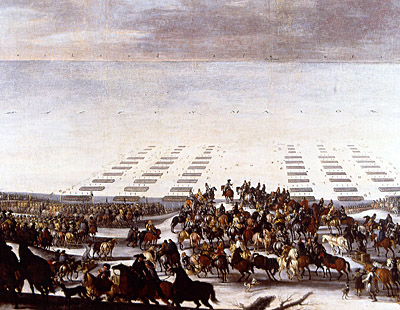| Karl Gustavkrigene

| | I 1657 rammer katastrofen for alvor det danske rige. Danmark erklærede Sverige krig i håb om at kunne få revanche for nederlaget i 1640erne, men bliver i stedet rendt over ende i løbet af sommeren 1657 og den efterfølgende vinter, hvor Karl 10. Gustav sætter over isen til Sjælland og hastigt nærmer sig København. |
Karl Gustavkrigene 1657-60
1657 ramte katastrofen for alvor det danske rige. Danmark erklærede Sverige krig i håb om at kunne revanchere nederlaget fra 1640erne, men bliver i stedet rendt over ende i løbet af sommeren 1657 og den efterfølgende vinter, hvor Karl 10. Gustav sætter over isen til Sjælland og hastigt nærmer sig København.

Karl 10. Gustav | 
Over isen til Fyn | 
Ivernæs | 
Erik Dahlberg | 
Karl 10. Gustav ved Storebælt |
| |
![]() | | Stor | Karl Gustav 10.s hær går over isen |
Roskildefreden
Der sluttes en hurtig fred i Roskilde. Fredsforhandler på svensk side er den tidligere danske rigshovmester Corfitz Ulfeldt, som er gift med Christian 4.s datter ElenoraChristine.
Fredsbetingelserne er hårde: Danmark skal for altid afgive Skånelandene, selvom § 9 i freden sikrer kulturel selvbestemmelse i Skåne.Besættelsen afsluttes med et såkaldt fredstaffel på Frederiksborg Slot,hvorefter svenskekongen via Helsingør drager til Skåne, for at tage de erobrede områder i øjesyn.

Roskildefreden | 
Præstegården i Høje Taastrup | 
Joachim Gersdorf | 
Corfitz Ulfeldt | 
Ankomsten til Frederiksborg Slot |

Ankomsten til Frederiksborg Slot (udsnit) | 
Ankomsten til Frederiksborg Slot (udsnit) | 
Ankomsten til Frederiksborg Slot (udsnit) | 
Ankomsten til Frederiksborg Slot (udsnit) | 
Festen på Frederiksborg Slot |

Karl 10. Gustav i Helsingør | 
Karl 10. Gustav modtages i Helsingborg | 
Karl 10. Gustav ankommer til Landskrona | 
Karl 10. Gustav ankommer til Malmø | 
Karl 10. Gustav uden for Christiansstad |

Skåne 1662 |
Anden halvleg
Et halvt år senere fortryder Karl d.10 Gustav at han ikke med det samme indlemmede hele Danmark i Sverige. Han besætter atter Sjælland og indtager Helsingør og Kronborg, som falder efter tre ugers belejring. København belejres, men undsættes, efter et søslag i Øresund, af en hollandsk flåde, idet hollænderne nu er i alliance med Danmark, og i henhold til aftalen kommer den angrebne part til hjælp.
Begivenhederne kulminerer med stormen på København i februar måned 1659, hvor det svenske angreb blev slået tilbage.

Belejringen af Kronborg
| 
Belejringen af Kronborg | 
Søslaget | 
Søslaget i Øresund | 
Slaget i Øresund |

Slaget i Øresund
(Tegning) | 
Stormen på København 1659 | 
Stormen på København 1659 | 
Dahlsbergs skitse fra angrebet | 
Øjebliksskitse |
| |
 | | Stor | Søslaget i Øreund |
Freden i København
Der sluttes atter fred i 1660, hvorved Bornholm vender tilbage til Danmark og Trondhjems Len til Norge. Ændringer vedrørende Skåne, Halland og Blekinges status var slet ikke på tale og det er tydeligt, at Danmarks allierede Holland og de øvrige europæiske stormagter ikke ønsker ændringer i forholdene omkring Øresund. Den storpolitiske manøvre går ud på at forhindre at en og samme magt fremover kommer til beherske begge sider af Øresund.
En senere iagttager, englænderen Robert Molesworth, bemærker i 1691 at Christian 4. i sin tid var begunstiget af hollændernes krig med Spanien og at kong Jacob d.1. af England favoriserede danskerne på grund af sit ægteskab med en dansk prinsesse. Molesworth bemærker at den danske suverænitet over Øresund ville svare til at Spanien havde påberåbt sig herredømme over Gibraltarstrædet og indsejlingen til hele Middelhavet. Øresundstolden eksisterer fortsat, men indtægterne er ifølge Molesworth faldet fra omkring 150.000 rigsdaler i 1645 til ca. 80.000 i 1690erne.

Axel Urup (1601-71) | 
Fredstraktaten 1660 |
|